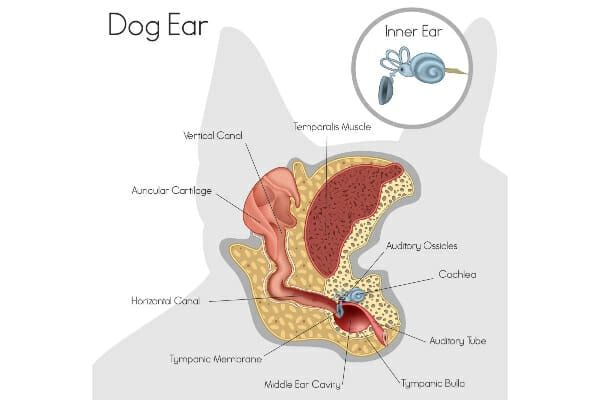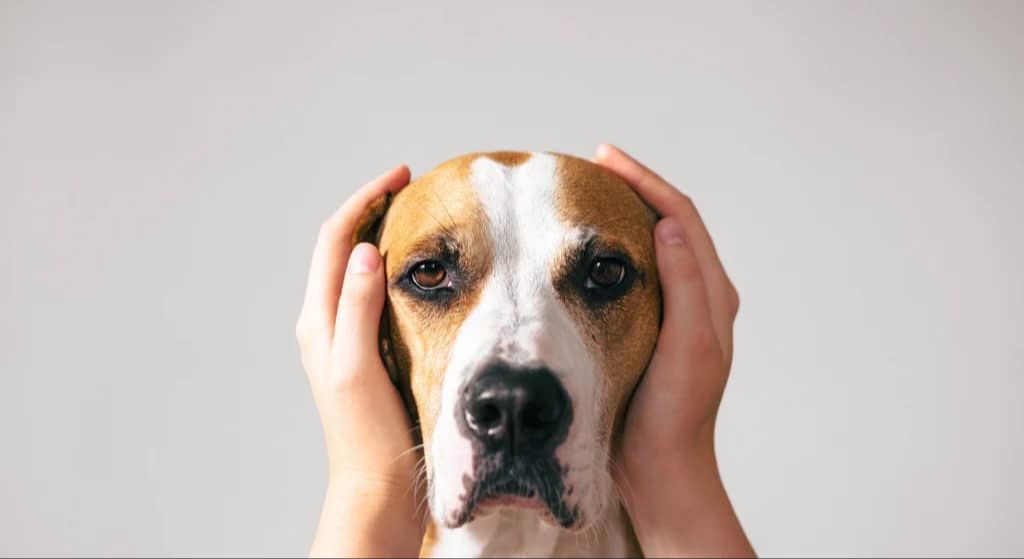Introduction
Dogs have an incredible sense of hearing that far surpasses human capabilities. According to researchers, the average hearing range for dogs is approximately 40Hz to 60,000Hz, compared to a human’s range of 20Hz to 20,000Hz (https://www.lsu.edu/deafness/HearingRange.html). This means dogs can hear sounds at a much higher frequency and lower frequency than humans can even perceive. While their exceptional hearing abilities allow dogs to pick up on subtle cues in their environment, it also makes them more sensitive to loud noises, especially high-pitched sounds.
Anatomy of a Dog’s Ear
A dog’s ear consists of three main parts: the outer ear, the middle ear, and the inner ear. The outer ear includes the pinnae (the visible flap that is often floppy) and the ear canal. The pinnae collect sound waves and direct them down the ear canal to the eardrum. The eardrum separates the outer and middle ear. When sound waves hit the eardrum, it vibrates and sends these vibrations to the middle ear.
The middle ear contains three tiny bones called the malleus, incus and stapes which transmit the vibrations to the inner ear. The inner ear contains the cochlea which is filled with fluid and contains tiny hair cells. As the vibrations move through the cochlea, the fluid moves and bends the hair cells. The hair cells convert these mechanical vibrations into electrical signals that travel via the auditory nerve to the brain, where they are interpreted as sound (source).

Hearing Range of Dogs
Dogs have a much wider range of hearing compared to humans. According to research from Louisiana State University, dogs can detect sounds between 67-45,000 Hz, while humans can only hear sounds between 64-23,000 Hz[1]. This means dogs can hear frequencies more than twice as high as the upper range of human hearing.
Dogs hear best between 4,000-8,000 Hz and are most sensitive to sounds around 4,000-10,000 Hz according to the same LSU study[1]. This range is significantly higher than the peak sensitivity for human hearing. Sounds at this frequency may be very difficult or impossible for humans to hear.
The American Kennel Club notes that dogs can hear sounds up to 65,000 Hz[2]. This upper limit far exceeds what humans can detect. High frequency sounds like dog whistles produce no discernible experience for people, but can be heard loudly by dogs.
Sounds That Are Too Loud
Dogs have extremely sensitive hearing and can detect a wider range of frequencies than humans. Their hearing range is approximately 40 Hz to 60,000 Hz, compared to a human’s range of 20 Hz to 20,000 Hz (Psychology Today). This means dogs can hear higher pitched sounds that are inaudible to our ears.
Sounds starting at 85 decibels (dB) can potentially cause pain or damage to a dog’s hearing, especially with prolonged exposure (Critter). As a comparison, normal human conversation is about 60 dB, while a motorcycle engine running can reach 95 dB. Exposure to sounds above 85 dB put dogs at risk for irreversible hearing loss or pain (Spot on Fence).
It’s important to limit extremely loud noises around dogs whenever possible. Things like fireworks, gunshots, concerts, or even loud music played through speakers carry risks. Pay attention to your dog’s body language for signs of distress when loud sounds occur.
High Pitched Sounds
Certain high pitched sounds can be unpleasant or even painful for dogs due to their sensitive hearing. Dogs have a wider hearing range compared to humans, able to detect sounds between 67-45,000 Hz. In comparison, humans can only hear sounds between 64-23,000 Hz.

High pitched sounds that dogs may find aversive or damaging include whistles, musical instruments, vacuum cleaners, blenders, power tools, squeaky toys, and alarms. The frequency of these noises often exceeds what is comfortable for a dog’s hearing. Prolonged exposure can cause pain, distress, and even temporary or permanent hearing loss in dogs if high decibel sounds are too loud.
Whistles and dog training tools that emit high pitched sounds like ultrasonic deterrents are designed to get a dog’s attention. However, they may be unpleasant for dogs when used excessively. Vacuum cleaners and blenders also produce persistent high pitched noise that a dog may find unpleasant, especially when very close to the source.
Squeaky toys are designed to mimic the sound of prey in distress. However, the high pitched squeak can become irritating and overstimulating for dogs during long play sessions. Dogs that destroy squeaky toys by removing the squeaker may be showing their dislike for the high pitched sound.
Knowing what kinds of high pitched noises may bother your dog can help you limit their exposure to protect their hearing and prevent distress.
Signs of Distress
Dogs can show various behavioral changes when they hear unpleasant or painful sounds. Some common signs of distress include:
- Cringing, cowering, or trying to get away from the noise source – Dogs may tuck their tail between their legs, hunch down, or back away when hearing a harsh sound.
- Pacing or restlessness – The dog may seem unable to settle down and paces around anxiously when exposed to loud sounds.
- Excessive barking or whining – Dogs may vocalize more in response to annoying noises as if pleading for it to stop.
- Acting “spooked” or startled – High-pitched sounds can trigger a fearful reaction as the noise hurts their sensitive ears.
- Panting and drooling – Some dogs salivate excessively and breathe rapidly when stressed by unpleasant sounds.
- Destructive behavior like chewing or digging – The dog may engage in repetitive behaviors to self-soothe their anxiety from noise.

According to the AKC, senior dogs may seem to “ignore” cues when losing their hearing as high-pitched sounds become difficult for them to perceive (source). Owners should be alert for signs of distress and take steps to minimize exposure to painful sounds.
Preventing Harm
There are several ways to modify your home environment to make it quieter for dogs that are sensitive to noise. Here are some tips:
- Install soundproofing materials – Adding mass loaded vinyl, acoustical insulation, or soundproof drywall can help absorb and block noise in rooms. Target areas like walls adjoining noisy spaces. (Source: https://www.soundproofcow.com/how-to-build-a-soundproof-dog-house/)
- Soundproof windows – Installing thick window plugs or special soundproof window inserts can reduce outside noise from coming into the home. This can help muffle noises like traffic, construction, or loud neighbors. (Source: https://indowwindows.com/resources/blog/muffle-dog-barking)
- Create a quiet space – Designate a “safe spot” in your home where your dog can retreat when they need relief from noise. Use rugs, blankets, and soft furniture to absorb sound in this area.
- Mask loud noises – Try using white noise machines, calming music, or water fountains to help cover up disruptive noises with comforting background sounds.
With some simple modifications, you can create a quieter home environment that protects your dog’s sensitive hearing.
Training Tips
Many dogs are fearful of loud noises, but there are ways you can help your dog learn to accept certain loud sounds through training and desensitization. The key is to start slowly and make loud noises a positive experience.1

Begin by exposing your dog to quieter sounds and slowly increase the volume over multiple training sessions. For example, you can start by playing firework or thunderstorm sounds very softly on your phone or laptop. Pair the sounds with something positive, like feeding your dog a treat. Gradually increase the volume over days and weeks as your dog remains calm and relaxed. Go slowly to avoid overwhelming your dog.
Create additional positive associations with loud noises by giving your dog attention or their favorite toy when they hear a loud sound and remain calm. This reinforces the behavior you want to see. You can also try counterconditioning by making loud noises yourself (like keys jangling or pots banging) and immediately giving your dog something positive.
Remain calm, patient, and positive during this training process. Never punish your dog for being afraid. With time and consistency, you can teach your pup that loud sounds are nothing to fear if introduced gradually and paired with positive experiences.2
When to See the Vet
Certain symptoms like ear infections may warrant medical attention from a veterinarian. Signs that your dog’s ear issue requires professional veterinary care include:
- Severe head shaking or scratching at the ears
- Discharge or blood coming from the ears
- Loss of balance or disorientation
- Redness, swelling or tenderness of the outer ear
- Persistent whining or whimpering
- Loss of hearing or reactivity to sound
- Foul odor coming from the ears
- Crusting or scabbing around the outer ear
Ear infections, in particular, require prescription medications to clear up the infection. Letting the infection go untreated can lead to permanent damage of the ear canal or eardrum. It’s important to have your vet examine your dog’s ears and determine the cause of discomfort. They can prescribe ear drops, oral antibiotics or anti-inflammatory medications as needed. The sooner treatment begins, the better chance your dog has for a quick recovery.
Conclusion
In summary, dogs have sensitive hearing and can be negatively impacted by excessively loud sounds, especially high-pitched frequencies. While barking, loud music, or other sharp noises may not seem bothersome to humans, they can actually be painful for dogs and cause hearing damage over time. By understanding your dog’s hearing abilities, watching for signs of distress, and taking preventative measures, dog owners can maintain their pet’s ear health and quality of life. If you suspect your dog may have suffered hearing loss or injury, take them to the vet for an evaluation. With proper care and attention, we can keep our canine companions comfortable while enjoying activities together. By making smart choices to control noise levels and not overexposing dogs to potentially dangerous decibel levels, we can let them live their happiest, healthiest lives.